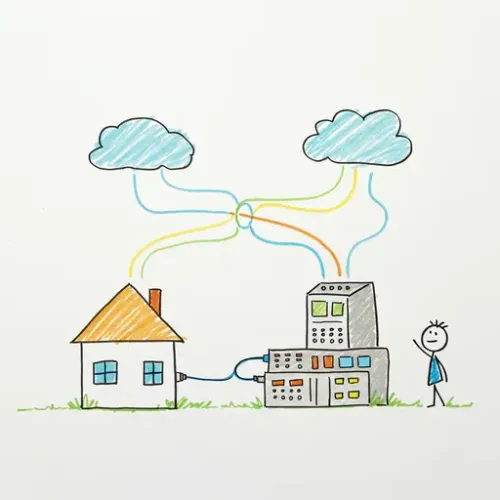Safeguarding Your Smart Home: Implementing Reliable Backups with Home Assistant and Google Drive

NGC 224
DIY Smart Home Creator
Your Home Assistant instance is the brain of your smart home, controlling everything from your lights and thermostat to your security system and media playback. You've invested time and effort into setting it up, integrating devices, writing automations, and perfecting your dashboards. But what happens when disaster strikes? A corrupted SD card, a failed update, a configuration mistake, or even hardware failure can bring your smart home to a grinding halt, potentially wiping away months or years of work.
This is where a robust backup strategy becomes not just a good idea, but an absolute necessity. While Home Assistant offers a basic local backup function, relying solely on backups stored on the same physical device that might fail is inherently risky. For true peace of mind and resilience, you need offsite, automated backups.
Introducing the Google Drive Backup Add-on
One of the most popular and reliable methods for achieving offsite backups in Home Assistant is by leveraging the free Google Drive Backup add-on. This community-developed add-on automates the backup process, securely uploads your backup files to your Google Drive account, and manages retention policies, ensuring you always have recent snapshots of your system available for restoration.
Using Google Drive provides several advantages:
- Offsite Storage: Backups are stored remotely, safe from local hardware failures, fires, or other physical disasters.
- Automation: Set it up once, and the add-on handles scheduled backups automatically.
- Accessibility: Access your backup files from any device with Google Drive.
- Easy Restoration: Restoring from Google Drive is a straightforward process within Home Assistant.
- Free Tier: Google Drive's free tier offers ample storage (15GB shared across services) for many Home Assistant backups.
Setting Up the Google Drive Backup Add-on
Installing and configuring the add-on is relatively simple via the Home Assistant Add-on Store.
Step 1: Installation
- Navigate to Settings -> Add-ons in your Home Assistant interface.
- Click on the Add-on Store button in the bottom right corner.
- Search for "Google Drive Backup".
- Click on the add-on and then click the Install button.
Step 2: Initial Configuration (Optional but Recommended)
Before starting the add-on, it's good practice to review its configuration.
- Once installed, the add-on page will appear. Click on the Configuration tab.
- Review the default settings. Key options include:
init_wait: How long to wait after Home Assistant starts before running the add-on.max_backups_in_google_drive: The maximum number of backups to retain in your Google Drive folder.max_backups_in_hassio: The maximum number of backups to retain locally within Home Assistant.folders_to_exclude: Allows you to exclude specific folders from the backup (useful for large, non-critical data). Be cautious with this unless you know exactly what you're doing.- Ensure Watchdog is enabled on the Info tab. This restarts the add-on if it crashes.
- Consider enabling Show in sidebar for easy access.
Step 3: Authentication with Google Drive
This is the most critical step – linking the add-on to your Google Drive account.
- Go to the Info tab of the Google Drive Backup add-on page.
- Click Start. Wait a few moments for it to initialize.
- Click the Open Web UI button.
- The add-on's web interface will guide you through the authentication process. You'll likely see a link that you need to click.
- Clicking the link will take you to a Google sign-in page. Log in to the Google account you want to use for backups.
- Google will ask for permission for the add-on to access your Google Drive. Grant the necessary permissions.
- After granting permission, you'll be presented with an authentication code. Copy this code.
- Return to the add-on's web interface and paste the copied code into the provided field. Click Submit.
- If successful, the web UI will confirm that authentication was successful. You should now see details about your Google Drive space and existing backups (if any) managed by the add-on.
Step 4: Scheduling Backups
Back in the Add-on's web UI, navigate to the Folders & Scheduling section.
- You can choose which types of backups to create (Full is recommended for complete system recovery).
- Set the desired Backup Interval (e.g., Daily, Weekly).
- Specify the Backup Time (choose a time when your system isn't typically under heavy load).
- Click Save Settings.
The add-on will now automatically create backups according to your schedule and upload them to a dedicated folder (usually named "Home Assistant Backups") in your Google Drive.
How Backups Relate to Your Devices
When the Google Drive Backup add-on creates a "Full backup", it saves your entire config directory, add-on data, and the Home Assistant database. This means:
- Integrations: Configurations for all your integrations (Zigbee2MQTT, Z-Wave JS UI, MQTT, ESPHome, etc.) are saved.
- Devices: While the state of devices at the exact moment of backup isn't guaranteed to be perfect, the *configuration* that allows Home Assistant to communicate with and control those devices is backed up. This includes critical network keys (like Zigbee network keys or Z-Wave S2 keys) if stored within Home Assistant or its add-ons.
- Automations, Scripts, Scenes: All your logic is preserved.
- Dashboards (Lovelace): Your UI configuration is saved.
- Add-ons: Data and configurations for installed add-ons (like Node-RED flows, Samba Share settings, etc.) are typically included, depending on how the add-on stores its data.
- Database: Your history and logbook data are backed up, though restoring a very large database can take time.
Upon restoring a backup, Home Assistant will essentially be rolled back to the state it was in at the time the backup was created. Devices connected via integrations might take some time to reconnect and report their current state, but they should be recognized and controllable without needing to re-pair or reconfigure from scratch (assuming the underlying hardware and network are functional).
Best Practices for Managing Reliable Backups
Simply setting up automated backups isn't enough. To ensure true reliability, follow these best practices:
- Verify Your Authentication: After setup, check the add-on's web UI and your Google Drive to confirm that the first scheduled backup successfully ran and the file appeared in your drive.
- Test Your Restoration Process: This is arguably the MOST important step. Periodically, perform a test restore on a separate machine (e.g., a spare Raspberry Pi or a virtual machine) if possible. This confirms that your backup files are valid and that you know the steps required to get your system running again. Don't wait until a disaster strikes to learn how to restore!
- Understand Retention Policies: Configure
max_backups_in_google_driveandmax_backups_in_hassiocarefully. Keeping too few backups might mean you don't have a valid state to revert to if a problem isn't discovered immediately. Keeping too many can consume excessive storage. Balance your needs and available space. - Use Full Backups: While partial backups are faster, a full backup guarantees that your entire system configuration, including add-on data, is saved. This simplifies the restoration process immensely.
- Secure Your Credentials: Your Google account is linked to your Home Assistant. Ensure your Google account is secured with a strong password and Two-Factor Authentication (2FA).
- Document Your Setup: Keep a separate record of crucial information not contained in the backup itself – your Home Assistant login credentials, your router's login, any static IP addresses, critical network keys (Zigbee/Z-Wave if managed externally), and importantly, the location of your Google Drive backups and the associated Google account.
- Monitor the Add-on: Occasionally check the add-on logs for any errors related to backup creation or uploading. You can also set up Home Assistant notifications based on the add-on's state or specific log messages if it supports them.
- Keep Home Assistant and the Add-on Updated: Ensure you are running reasonably current versions of Home Assistant and the Google Drive Backup add-on to benefit from bug fixes and new features.
Troubleshooting Common Issues
- Authentication Failed: Double-check the steps for copying and pasting the authentication code. Ensure you are logged into the correct Google account. Sometimes, revoking permissions in your Google account settings (under Security -> Third-party apps with account access) and re-authenticating helps.
- Backups Not Uploading: Check the add-on logs for specific error messages. Ensure Home Assistant has network connectivity and can reach Google's servers. Verify that your Google Drive isn't full.
- Incomplete Backups: This can sometimes happen if the system is under heavy load during the backup process or if there are permissions issues accessing certain files. Check the logs.
Conclusion
Implementing a reliable backup strategy is a fundamental step in managing a stable and resilient Home Assistant smart home. The Google Drive Backup add-on provides an automated, offsite solution that is easy to set up and incredibly effective. By following the setup steps and best practices outlined above, you can significantly reduce the risk of data loss and ensure that you can quickly recover your smart home configuration in the face of unexpected issues. Don't wait for something to go wrong – set up your backups today and gain the peace of mind that comes with knowing your smart home is safeguarded.

NGC 224
Author bio: DIY Smart Home Creator
